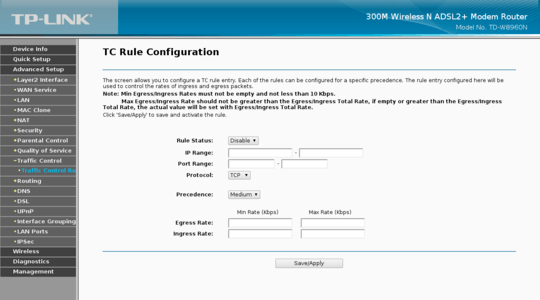4
if this question should be moved to some other site please let me know.
I'm trying to configure traffic control on my TP-LINK TD-W8960N modem router. From what I can see in the configuration screen I have to set a maximum upload and download speed for the WAN, which is set to the line's maximum. Then I have to specify rules for different IP ranges, being able to select protocol, ports, a precedence, and min/max upload/download speed.
My questions are: What is the meaning of the min and max speeds? How is the total speed distributed? What if one PC is idle, can the rest use up it's bandwitdh?
The manual was of no help.
Here's a screenshot of the rule creation page:

Sure, that makes sense. But what if the sum of min bandwidth's exceed the total? And where does precedence come in? Do all the minimums get reserved first, or is it traversed by precedence first?
Of course I don't expect you to know about this particular implementation, but maybe know about what is standard in these cases :)
Thank you! – Guido – 2012-02-10T21:42:26.140
Honestly, everyone has their own
standardwhen it comes to traffic shaping. Most expensive devices will let you setup tier'd filters which you can class bandwidth into different categories and allocate bandwidth on each level in the tier... etc... One important piece of advise. A router does not know how much bandwidth you have overall... the closest guess is that it has the maxiumum port-speed. (i.e. 100mbt, 1-gigabit... 10mbt... 54mbt... etc...) For TC to be effective, you need to be able to tell the router how much you have (i.e. 8mbt) and then restrict bandwidth fir specific reasons – TheCompWiz – 2012-02-10T21:48:00.987